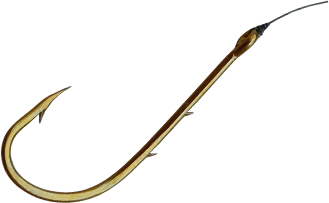Four Fishing techniques
every angler should know
Suspend drifting
Your bait is suspended beneath your bobber and slowly moved through the water by the motion of the boat.
Anchoring
Drop an anchor to keep your boat in one spot. This will allow you to target the fish there.
dead sticking
Sink your bait and let the rod sit there motionless. The wind and the waves work it.
tightlining
Attach the sinker at the end of your line with the hook above it. This allows you to use a heavier weight, which is great for river fishing.
What Type of Hooks Work
Best For Catfishing?
The circle hook
When the catfish are really biting, from the middle of June through the fall months, you’ll want to keep plenty of circle hooks in your tacklebox. Circle hooks are designed to turn quickly and hook catfish in the mouth, rather than the gut, so catfish are more likely to stay hooked during the battle and can be released with little or no harm. Another cool thing about circle hooks is that you don’t have to set the hook. Circle hooks virtually set themselves, which makes them great for anchoring, tightlining or dead sticking and when you have your rod in a rod holder.
For big catfish, choose sizes from 8/0 to 10/0 hooks. There are numerous brands with some of the most popular being Gamakatsu, Team Catfish, Mustad, Eagle Claw and Trokar. Beware of the Trokar hooks – they’re wicked sharp! The No. 1 hook we sell is a Gamakatsu Circle size 8/0.

The J hook
When the fish bite very light and it’s up to you to set the hook, J hooks are the way to go. Sizes 8/0 to 10/0 seem to be the most popular, with Gamakatsu Octopus, Team Catfish Double Action and Trokar Octopus leading the field. J hooks are ideal for winter fishing.
how to choose the right
sinker for trophy catfishing
Slip Sinkers

Unlike a bank weight that sinks right to the bottom of the water, slip sinkers slide up and down the line. When a catfish strikes, it can turn to the side and “run” with the bait until you’re ready to set the hook. Slip sinkers are effective for smaller fish and big trophy-class cats alike. And they can be used in any body of water from lakes and reservoirs to big rivers or ponds.
bank weights

Big blues and other brutish fish love to hang out in deep water. So, if you’re going after bigger fish or fishing in heavier currents, tie a bank weight to your line. Bank weights cut through the current to put your bait right in front of those hefty bottom feeders. Their shape allows you to attach your line at the top, so your sinker is on the bottom while your bait is above it.
how much weight
should use?

The size of the sinker you use is typically determined by how much current there is where you are fishing.
If anchoring or tightlining, you want just enough weight so that it stays put and doesn’t move around. Here on the Mississippi River in the St. Louis area, that could be anywhere from 4 to 16 ounces of weight.
What bait is good for
catching blue cats?
Blue cats are eating machines, so they’re not very picky about the bait dangled in front of them. But the temperature of the water does make certain cut bait more appetizing. Keep those big fish biting all season with these handy bait tips.

cut bait
From January through March, use shad. From April through October, use skipjack or herring. And during the dog days of summer, use Asian carp.

live bait
Goldfish, legally caught bluegill or very large shiners work great. And if you can keep them
alive, shad or skipjack are tough to beat.
